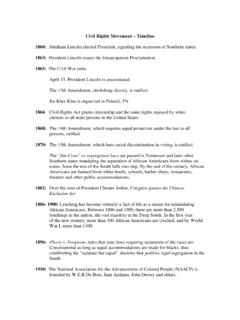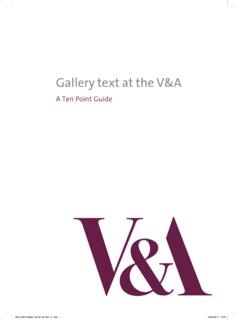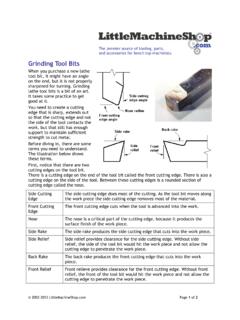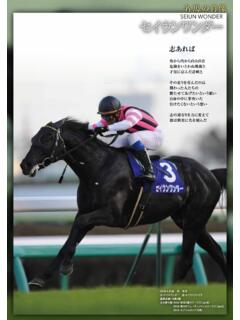Transcription of Think Like a Curator - University of Maryland Art Gallery
1 How to Design an Exhibition Think LIKE A CURATORV ocabularyCurator an art specialist responsible for a museum's collection and exhibitions. Exhibition designer designs exhibition spaces, paints walls, arranges artwork, usually under the supervision of the Curator . Center line The imaginary line exhibition designers use to hang artworks. The middle of the painting usually falls between 54 and 62 inches. Accent wall A single wall painted in a contrasting color from the rest of the space. It focuses viewer s attention and directs people around the space. Anchor Piece usually the largest or strongest pieces of an exhibitionWall text information provided by the Curator for each artwork.
2 It is the Curator s choice as to how much information is to be provided. Decide the themefor your exhibition. A themeis a unifying idea or motif. The broader the theme, the easier it is to find works that fit the theme. The narrower it is, the more cohesive your show will look and feel. EXAMPLEP rintmaking vs. contemporary silk screen rock posters = A VERY large pool of work to choose from vs. a smaller, more specific pool. Select a ThemeKnow the parameters of your space, and let that guide how many pieces should be exhibited. Think : How many pieces will fit in the Gallery ? How does putting many pieces in an exhibition send a different message than putting just a few?
3 Know Your SpaceKnow Your SpaceThink of curating an exhibition like writing an essay you want to present your work in a certain way. Think : Would you like the work set up chronologically? If so, will you provide a timeline? Do you want to provide other content? (Photographs, other artworks, historical objects, quotes from the artist, etc.) Providing InformationStart by choosing a lot (30 to 40) of artworks. Next, narrow down your selection to best fit your you do a research paper, you don t use all of those sources you read but choose what supports your thesis the strongest. Think : What artworks best tell the story of your exhibition?
4 Selecting ArtworksStandard Labels Includes: Name of the artist Title of Work Dimensions of the object What the artwork is made of (the media) Date of creation Owner of workDidactic (or extended) Labels Includes: All of the information as a standard label PLUS additional information on the work ( history, reason why it fits in the exhibition) related to the exhibition themeWall texts are a way to directly communicate with the viewer. Write a LabelWhen designing your exhibition, always keep your viewer in like in writing, you must ask yourself: Who is my audience? What do I want to communicate to them?
5 How do I do that in the Gallery space?These questions will help guide your design DesignThe color of the walls can effect the mood and shape of the spaceWhite walls are clean and sterile and suggest the experience is mainly about the work. Painting an entire room can change the feel of the space. Think : How will a wall color affect the mood of the space? What happens when I paint all the walls black? Bright yellow? Deep Red? Should I use one color or more than one?Pick a Wall ColorCenter Line The institutional standard Artworks are hung with the center of the artwork hitting between 54 and 62 Salon Style Artworks are hung from ceiling to floor Think : What are the pros/cons of these two styles?
6 What will help me convey the theme of my exhibition?Hanging Your WorkMost people walk into a Gallery and go to the right. As a result, curators often use that fact and an accent wall to lead their viewer into and through the space. Think : How can I lead my viewer into and through my show? If my viewer went the wrong way, would my theme still work? Why or why not?Guide Visitors Around the SpaceWhen you start to arrange the artworks, certain pieces will standout as anchor pieces(often the strongest or largest artworks).Select three or four anchor pieces and spread them out in the Gallery . (Do not group them together!)
7 This will help steer your viewer through the : What makes this artwork an anchor piece? How will this anchor piece direct my viewer through the space?Guide Visitors Around the SpaceThink about activities or walls that ask the visitor to join in or somehow contribute to the exhibition. Think : How can I engage my visitors? After viewing the work, how can I get my viewer to respond? Get Creative!START PLANNING!ResourcesFind a great list of museum definitions here: SketchUp Tutorials Here.







